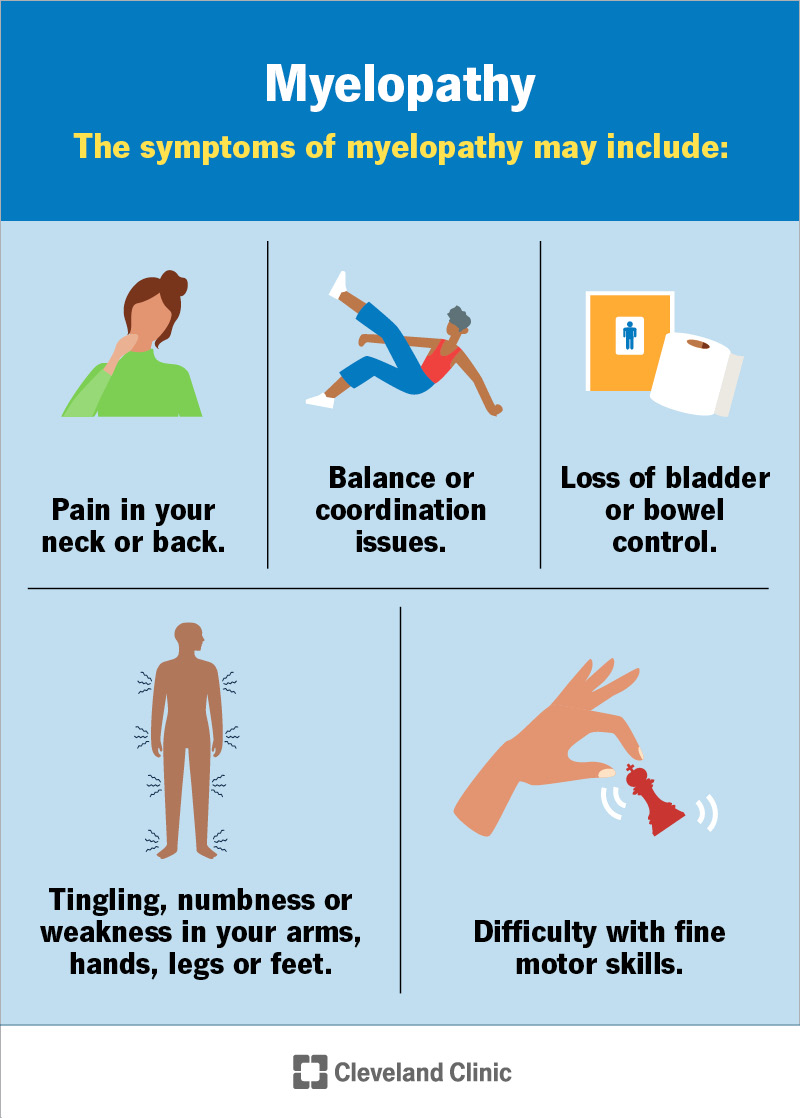Myelopathy is spinal cord compression. It can cause pain, numbness and difficulty moving certain parts of your body. It can happen after a traumatic injury, natural aging or a herniated disk. Myelopathy symptoms can get worse if left untreated. Your provider may offer nonsurgical options before decompressing your spinal cord with surgery.
Advertisement
Cleveland Clinic is a non-profit academic medical center. Advertising on our site helps support our mission. We do not endorse non-Cleveland Clinic products or services. Policy
Myelopathy is a collection of symptoms caused by spinal cord compression. When something compresses (presses against or squeezes) your spinal cord, it can’t function properly. That can lead to pain, loss of feeling or difficulty moving certain parts of your body.
Advertisement
Cleveland Clinic is a non-profit academic medical center. Advertising on our site helps support our mission. We do not endorse non-Cleveland Clinic products or services. Policy
Your spinal cord is a collection of nerves that carry messages between your brain and body. It sits inside the hollow area of your spine (spinal canal). The bones in your spine (vertebrae) protect your spinal cord. Several diseases and conditions can weaken your vertebrae, along with other supporting structures in your spine, and cause them to compress your spinal cord.
You’ve likely lost feeling or felt pins and needles in your hand after leaning on your elbow for too long. Now, imagine if that feeling didn’t go away when you readjusted your position. Myelopathy can make everyday tasks like holding a pen or buttoning your shirt a real pain (in your neck and back).
Over time, myelopathy symptoms may get worse, so don’t hesitate to contact a healthcare provider if something doesn’t seem right. A provider can help you manage symptoms with nonsurgical options or treat myelopathy with surgery.
There are three types of myelopathy. Each one is named for the affected area of the spine:
Advertisement
If left untreated, myelopathy may get worse. It could lead to severe pain, permanent nerve damage and other severe complications like paralysis. Let a healthcare provider know if you experience symptoms of myelopathy.

The symptoms of myelopathy may include:
Spinal cord compression affects the nerves that control many of your body’s movements and functions. Different areas of the spinal cord control different functions. Symptoms of myelopathy vary based on which part of your spinal cord it affects.
Anything that compresses your spinal cord can cause myelopathy. Common causes of spinal cord compression include:
Myelopathy can affect anyone at any age. Degenerative forms of myelopathy are more common in adults over age 40. Research shows that males develop myelopathy more often than females.
A healthcare provider will diagnose myelopathy after a physical exam, neurological exam and testing. During the exams, your provider will learn more about your symptoms and medical history.
To confirm a diagnosis, your provider will order tests. These tests may include:
Treatment for myelopathy varies based on where you have spinal cord compression and what caused it. The best treatment for you may vary from someone else. Your healthcare provider might recommend nonsurgical and/or surgical treatment options specific to your situation.
Nonsurgical treatments can help relieve symptoms, but they don’t decompress your spinal cord. If your symptoms are minor or you’re waiting for surgery, your provider may recommend nonsurgical care like:
If you have myelopathy, surgery can decompress (relieve pressure on) your spinal cord. Your provider may consider surgery if nonsurgical options don’t relieve your symptoms or if your symptoms are severe enough to cause complications.
Advertisement
Surgeons use spinal decompression surgery to treat myelopathy. Your surgeon may use one or multiple procedure types to address myelopathy:
Your surgeon will explain the risks and benefits of the procedure so you can make an informed decision about your health.
It’s important to seek care if you notice symptoms of myelopathy. Even if your symptoms aren’t severe, they can still be irritating and make everyday tasks a little more challenging.
Left untreated, myelopathy may get worse over time. Spinal compression can damage the nerves that control your essential body movements and functioning. You can’t reverse nerve damage, so complications may be permanent. Surgery can treat this condition.
This varies from person to person based on what caused symptoms and the severity. Myelopathy complications may affect your life expectancy and your quality of life. Your healthcare provider will give you the most up-to-date information on how myelopathy affects you and what you can expect.
You can’t always prevent myelopathy. Some myelopathy results from normal wear and tear due to aging.
You may be able to reduce your risk of some causes of myelopathy by taking steps to strengthen and care for your back. For example, be sure to lift heavy objects with your legs and core, not your back and upper body only. With good back care, you can reduce the likelihood or severity of some back injuries.
Advertisement
You should call your healthcare provider if you experience:
You may want to ask your healthcare provider:
Your spinal cord has a very important job in your body. Any pressure on it could affect how well it’s able to communicate with your brain and nerves.
There are many different treatment options for each cause of myelopathy. A healthcare provider will evaluate how symptoms affect you and what treatment will work best for your situation. Surgery may be a consideration, especially if you have severe symptoms.
Advertisement
Back pain can stop you in your tracks. But you don’t have to live like that. Cleveland Clinic is here to help you get moving again.

Last reviewed on 01/28/2025.
Learn more about the Health Library and our editorial process.